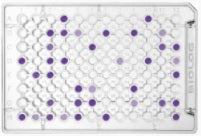Microbiome
Supplied By: Biolog, USA
Rs. 0.00
Research into Human, Animal, Plant, and Environmental Microbiomes has exploded recently and new tools are being developed to study these communities, the types of microbes present, as well as the dynamics (stability or variability) of the communities. While metagenomic studies have revealed immense diversity, additional tools are required to understand the community structure, function, and their interaction with host environments
Biolog has unique solutions and choices for metabolic profiling of bacterial communities, as well as individual strains of interest, including those that are anaerobic or microaerophilic.

Community Analysis
AN (Anaerobic) MicroPlates
-
A 96 well plate containing 95 carbon sources specifically selected for anaerobic bacteria using a colorimetric redox dye
-
Plates can be read in the OmniLog instrument which provides important advantages for throughput, kinetics, and accessing Biolog data analysis software. Plates can also be read on the MicroStation or other microplate readers
-
Results are obtained in 24 hours or less, usually within 8 hours
-
Contact BIOLOG for a Protocol
Phenotype MicroArray MicroPlates
-
Collection of 20 defined plates representing 1920 phenotypic tests to investigate aspects of cellular metabolism, as well as sensitivity to a broad range of microbial inhibitors
-
Click here for more information on Phenotype MircroArray Technology
-
In this method, these assays are growth-based and use turbidity rather than dye formation. Assays take typically 2 to 4 days depending on the specific anaerobe and their growth rate
-
The plates can be read in a microplate reader (OD-750) to measure cell density in the wells
Click here for a listing of chemicals in Phenotype MicroArrays MicroPlates 1-10 (metabolic panels)
Both of the above options require the use of an anaerobic chamber for inoculating the MicroPlates.
Aerobic Community Analysis
EcoPlates
-
Used by Microbial Ecologists for more than 25 years to assess the diversity of microbial communities. The EcoPlate contains 31 different carbon sources, repeated 3 times. The plate can be used for 3 different samples – or 1 sample in triplicate.
Gen III MicroPlates
-
Used for identification of more than 1,500 aerobic bacterial species. It contains 71 carbon source and 23 chemical sensitivity tests chosen to optimally differentiate aerobic bacteria. It can also be used to assess microbial community function.
-
Click here for a link to the GEN III MicroPlate Instructions for Use
Gen III MicroPlates
-
Collection of 20 defined plates representing 1920 phenotypic tests to investigate aspects of cellular metabolism, as well as sensitivity to a broad range of microbial inhibitors. In addition to profiling carbon metabolism, these plates also offer the option to profile nitrogen, phosphorus, and sulfur metabolism.
-
Click here for more information on Phenotype MicroArray Technology
-
When used with the appropriate redox dye, optimal results are achieved using an OmniLog (incubator, automation, reader) and associated software.
-
To receive a prescribed protocol, contact Biolog and request a PM Consult Form
Click here for a listing of chemicals in Phenotype MicroArrays MicroPlates 1-10 (metabolic panels)
Single Strain Identification and Metabolic Analysis
Multiple different plates can be used for species level identification of aerobes, anaerobes, yeast and filamentous fungi. In addition, all of these organisms can be used with the Phenotype MicroArray Plates to provide a full analysis of the cells’ metabolic and chemical and sensitivity phenotypes.
Plate Options Include:
-
GEN III MicroPlate - (Aerobe Identification)
-
AN MicroPlate - (Anaerobe Identification)
-
YT MicroPlate - (Yeast Identification)
-
FF MicroPlate - (Filamentous Fungal Identification)
-
Phenotype MicroArray Plates - (Detailed Phenotypic Characterization)
Related Products






